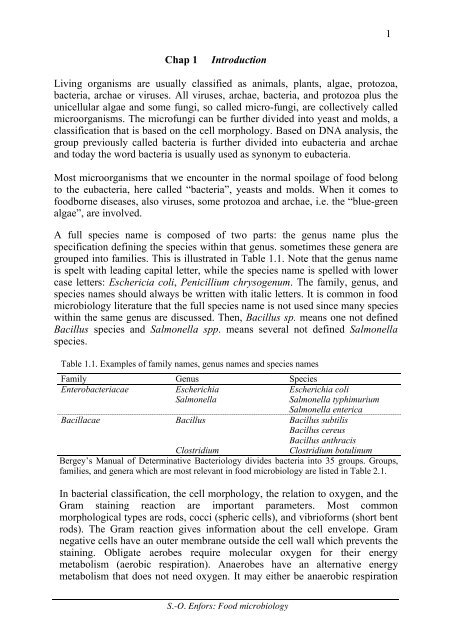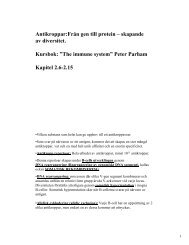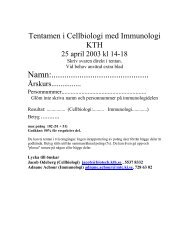Food Microbiology
Food Microbiology
Food Microbiology
- No tags were found...
Create successful ePaper yourself
Turn your PDF publications into a flip-book with our unique Google optimized e-Paper software.
1Chap 1IntroductionLiving organisms are usually classified as animals, plants, algae, protozoa,bacteria, archae or viruses. All viruses, archae, bacteria, and protozoa plus theunicellular algae and some fungi, so called micro-fungi, are collectively calledmicroorganisms. The microfungi can be further divided into yeast and molds, aclassification that is based on the cell morphology. Based on DNA analysis, thegroup previously called bacteria is further divided into eubacteria and archaeand today the word bacteria is usually used as synonym to eubacteria.Most microorganisms that we encounter in the normal spoilage of food belongto the eubacteria, here called “bacteria”, yeasts and molds. When it comes tofoodborne diseases, also viruses, some protozoa and archae, i.e. the “blue-greenalgae”, are involved.A full species name is composed of two parts: the genus name plus thespecification defining the species within that genus. sometimes these genera aregrouped into families. This is illustrated in Table 1.1. Note that the genus nameis spelt with leading capital letter, while the species name is spelled with lowercase letters: Eschericia coli, Penicillium chrysogenum. The family, genus, andspecies names should always be written with italic letters. It is common in foodmicrobiology literature that the full species name is not used since many specieswithin the same genus are discussed. Then, Bacillus sp. means one not definedBacillus species and Salmonella spp. means several not defined Salmonellaspecies.Table 1.1. Examples of family names, genus names and species namesFamily Genus SpeciesEnterobacteriacae Escherichia Escherichia coliSalmonellaSalmonella typhimuriumSalmonella entericaBacillacae Bacillus Bacillus subtilisBacillus cereusBacillus anthracisClostridiumClostridium botulinumBergey’s Manual of Determinative Bacteriology divides bacteria into 35 groups. Groups,families, and genera which are most relevant in food microbiology are listed in Table 2.1.In bacterial classification, the cell morphology, the relation to oxygen, and theGram staining reaction are important parameters. Most commonmorphological types are rods, cocci (spheric cells), and vibrioforms (short bentrods). The Gram reaction gives information about the cell envelope. Gramnegative cells have an outer membrane outside the cell wall which prevents thestaining. Obligate aerobes require molecular oxygen for their energymetabolism (aerobic respiration). Anaerobes have an alternative energymetabolism that does not need oxygen. It may either be anaerobic respirationS.-O. Enfors: <strong>Food</strong> microbiology






